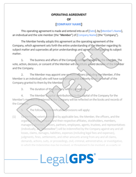Ultimate Guide to Lease Agreements: Essentials for Landlords, Tenants, and Businesses
 Chris Daming, J.D., LL.M. : Nov. 6, 2024
Chris Daming, J.D., LL.M. : Nov. 6, 2024
Lease agreements are crucial tools that establish the rights and responsibilities of both landlords and tenants across various leasing arrangements.
Whether you're renting commercial space, leasing equipment, or managing complex lease structures, understanding these agreements can save time, reduce risks, and clarify financial obligations. This guide dives into the essentials of lease agreements, outlining key types, common terms, and what both parties should know before signing.


Legal GPS Pro
Protect your business with our complete legal subscription service, designed by top startup attorneys.
- ✅ Complete Legal Toolkit
- ✅ 100+ Editable Contracts
- ✅ Affordable Legal Guidance
- ✅ Custom Legal Status Report
What Is a Lease Agreement?
A lease agreement is a binding contract that allows one party (tenant) to use a property, space, or equipment owned by another party (landlord) in exchange for periodic payments. These agreements can vary significantly based on the asset being leased—such as commercial property, equipment, or retail space—and are governed by specific terms and local regulations.
For example, a commercial lease for a retail store may include terms about permitted use, tenant improvements, and signage, while an equipment lease might focus on maintenance responsibilities, insurance, and replacement costs.
Lease agreements are important because they clearly define the expectations and responsibilities of each party, helping to prevent disputes and ensuring smooth operation throughout the lease term.
Types of Lease Agreements
Each type of lease has its own structure, purpose, and specific clauses to address unique requirements. Below is a more detailed overview of common lease types, including examples and actionable considerations for each:
Commercial Lease
A commercial lease is used for retail, office, or industrial space. These leases include customized terms based on the type of business and usually involve negotiation of rent, renewal options, and allowable uses.
A small business leasing office space may negotiate a commercial lease that includes clauses allowing subleasing if their business grows and they need to relocate to a larger space. The lease might also specify operating hours and types of permitted activities to ensure compliance with building rules.
-
Ensure your lease includes renewal options, which can provide stability for your business.
-
Confirm that the property is zoned for your intended use, as this can prevent costly issues down the line.
-
Consider adding a break clause that allows early termination under certain conditions, such as declining business revenue.
Equipment Leasing
Equipment leases are often utilized by businesses to avoid large upfront costs for essential equipment. These leases may include clauses on maintenance, upgrades, and replacement terms.
A construction company may lease heavy machinery like excavators. The lease might specify who is responsible for repairs and include an option to upgrade to newer equipment after a certain period.
-
Clearly outline which party is responsible for maintenance and repairs. Unexpected repair costs can significantly impact your bottom line.
-
Some equipment leases include a buyout clause at the end of the lease term, which can be beneficial if the equipment is still valuable to your business.
-
Make sure you understand the insurance requirements, including who needs to provide coverage and the types of risks covered.
Modified Gross Lease
A modified gross lease is a balanced option where tenants pay a base rent plus certain shared costs, making it less complex than triple net leases but more tailored than standard gross leases.
An office tenant may agree to a modified gross lease where they pay a fixed rent plus a proportionate share of utilities and common area maintenance.
-
Ensure all shared costs are clearly defined, including how they are calculated and any caps on potential increases.
-
Some landlords reconcile shared costs at the end of the year, which can result in additional charges. Make sure you understand how this process works.
-
Try to negotiate a cap on increases for shared costs to provide predictability in your budgeting.
Triple Net Lease
A triple net lease requires tenants to cover property taxes, insurance, and maintenance, reducing the landlord’s responsibilities. This type of lease is common for long-term, high-investment properties.
A retail tenant leasing a standalone building may enter into a triple net lease where they are responsible for maintaining the building, paying property taxes, and obtaining insurance.
-
Triple net leases can lead to significant additional expenses beyond rent. Make sure to budget for taxes, insurance, and maintenance.
-
Conduct a thorough inspection before signing, as maintenance obligations can be costly if the property is in poor condition.
-
Attempt to negotiate certain maintenance responsibilities back to the landlord, especially for major structural repairs.
Assignment of Lease
For tenants who wish to transfer their lease obligations to another party, an assignment of lease requires careful handling to ensure compliance with the original lease terms.
A tenant moving to a larger space may want to assign their existing lease to another business. The landlord's consent is typically required, and the original tenant may remain liable if the new tenant defaults.
-
Make sure to obtain written consent from the landlord before proceeding with an assignment.
-
Check if you will remain liable under the lease terms even after assignment. This could leave you financially responsible if the new tenant fails to pay rent.
-
When possible, negotiate a release from liability once the lease is assigned, especially if the assignee is financially stable.


Legal GPS Pro
Protect your business with our complete legal subscription service, designed by top startup attorneys.
- ✅ Complete Legal Toolkit
- ✅ 100+ Editable Contracts
- ✅ Affordable Legal Guidance
- ✅ Custom Legal Status Report
Essential Clauses in Lease Agreements
Whether it's a commercial, equipment, or residential lease, certain clauses are fundamental for protecting both parties. Here are some essential clauses with examples and actionable advice:
Rent and Payment Terms
Clear information on the amount, frequency, and acceptable payment methods is crucial.
A lease may specify that rent is due on the first of each month via electronic transfer, with a grace period of five days before late fees apply.
-
Clearly outline late fees to discourage delayed payments. Consider a tiered late fee structure to motivate timely payments.
-
Indicate acceptable payment methods (e.g., bank transfer, check) to avoid disputes.
-
For longer leases, include an escalation clause that details how and when rent will increase to account for inflation.
Duration and Renewal
Details on how long the lease lasts and the conditions for renewal or termination are key.
A commercial lease might have a term of five years, with an option for the tenant to renew for an additional five years at a predetermined rate.
-
Specify how much notice must be given if either party wants to renew or terminate the lease.
-
Agree on renewal rent and terms upfront to avoid uncertainty when the lease ends.
-
If possible, add a clause that allows early termination with adequate notice or a penalty fee.
Maintenance and Repairs
Responsibilities for both parties, from routine maintenance to major repairs, should be well-defined.
In a commercial lease, the tenant might be responsible for interior repairs, while the landlord handles structural maintenance.
-
Clearly define what constitutes routine maintenance versus major repairs.
-
Specify timeframes for repairs, especially those affecting the tenant's ability to use the property.
-
For complex properties, consider negotiating a shared maintenance schedule to avoid confusion.
Security Deposit
The amount required, acceptable uses, and conditions for refund should be outlined in detail.
A lease may require a security deposit equal to one month's rent, to be refunded within 30 days of lease termination, minus any deductions for damages.
-
Take photos and notes of the property condition at move-in to avoid disputes over deposit deductions.
-
Clearly outline what can be deducted from the security deposit (e.g., unpaid rent, damages beyond normal wear and tear).
-
In some jurisdictions, landlords are required to hold deposits in interest-bearing accounts. Make sure the lease complies with local laws.
Subleasing and Assignments
Rules around transferring the lease or allowing subtenants should be clear.
A tenant may be allowed to sublease with prior written consent from the landlord, with the original tenant remaining liable for lease obligations.
-
Specify the conditions under which subleasing is allowed, including any fees or requirements for approval.
-
Always obtain written consent from the landlord to avoid legal issues.
-
As a landlord, consider including a clause that allows you to reject subtenants who do not meet your criteria.
Pros and Cons of Different Lease Types
Each lease type offers unique advantages depending on your needs. Here’s a deeper dive into the pros and cons with actionable insights:
-
Ideal for businesses needing flexibility but can be costly.
-
Customizable terms to fit business needs.
-
Often includes hidden costs like maintenance fees.
-
Negotiate a cap on operating costs to avoid unexpected expenses.
-
-
Provides asset access with minimal upfront cost but may involve strict maintenance terms.
-
Keeps cash flow intact by avoiding large purchases.
-
You may end up paying more over time compared to buying outright.
-
Evaluate total lease costs versus purchase costs over the equipment's useful life.
-
-
Reduces landlord responsibilities but increases tenant obligations.
-
Stable investment for landlords with predictable income.
-
Tenants bear significant responsibility for property upkeep.
-
Tenants should budget for all potential costs and consider hiring a property manager if needed.
-
Understanding the pros and cons helps parties make informed decisions tailored to their financial and operational needs.
How to Draft or Review a Lease Agreement
For landlords, a well-drafted lease agreement protects property value and ensures compliance. For tenants, it ensures fair treatment and predictable costs. Here’s how to get started:
Outline Clear Terms
Define the purpose, rent, and lease type upfront.
A lease for office space should clearly state the rent amount, any expected increases, and the specific use of the space (e.g., professional services, retail).
-
Clearly outline how the space or equipment can be used to avoid disputes.
-
Include how often rent increases will occur and on what basis (e.g., CPI increases).
Specify Maintenance and Use Clauses
Address potential issues before they arise.
An equipment lease might specify that only certified technicians can perform repairs, ensuring the equipment remains in good condition.
-
Avoid vague phrases like "reasonable wear and tear." Be specific about what is allowed.
-
Outline what happens if urgent repairs are needed, including who is responsible for arranging and paying for them.
Do I need a business lawyer?
The biggest question now is, "Do you need a lawyer to help you with transactional agreements?” For most businesses and in most cases, you can DIY a lot of your legal issues. Many business owners rely on Legal GPS Pro to help with those issues.
Legal GPS Pro is your All-In-One Legal Toolkit for Businesses. Developed by top startup attorneys, Pro gives you access to 100+ expertly crafted templates including operating agreements, NDAs, and service agreements, and an interactive platform. All designed to protect your company and set it up for lasting success.

Legal GPS Pro
Protect your business with our complete legal subscription service, designed by top startup attorneys.
- ✅ Complete Legal Toolkit
- ✅ 100+ Editable Contracts
- ✅ Affordable Legal Guidance
- ✅ Custom Legal Status Report

Legal GPS Pro: All-in-One Legal Toolkit
100+ legal templates, guides, and expert advice to protect your business.
Trusted by 1000+ businesses


